#region de valparaiso
Explore tagged Tumblr posts
Text
Hi! Just wanna raise some awareness here because South America is on fucking fire and I need to see more people talking about this.

Source: RSOE EDIS x
Im just going to talk about the ones i'm closest to, but if you know about these fires, feel free to add in the reblogs!
Chile
In Chile there's (up to Feb 5) 160 wild fires, of which 40 are still trying to be controlled by authorities. The president, Gabriel Boric, has declared State of Emergency in the whole country, and theres a Red Alert Code in most part of the country.
Isla de Chiloé, Southern Chile (900 km away from Santiago de Chile)
This is a (recently controlled) fire that lasted a week, but many neighborhoods were burnt to the ground.
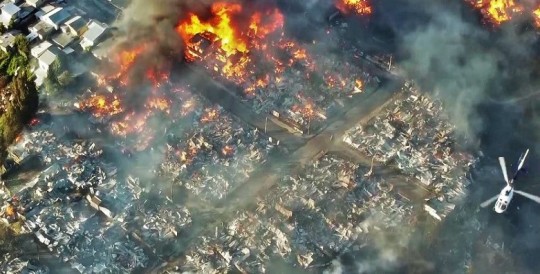
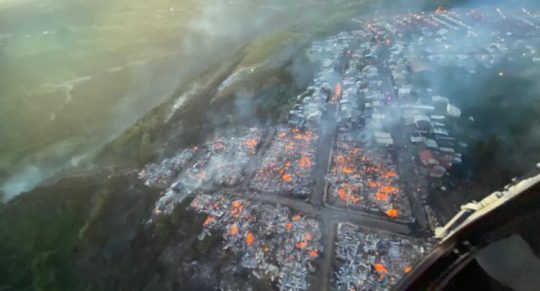
The whole South is in red alert for constant sudden fires that spread quickly due to the lack of rain and the elevated temperatues in the zone. Just today, two fires had to be controlled in the main land next to this island, and more are being reported in the Los Lagos region. This is added to the "controlled" intentional fires that farmers make to clean their fields of old crops along the Central-South parts of the country, mostly surrunding the main route, Ruta 5, that connects the whole country, thus making it hard to see and breathe because of the smoke. (flashnews, most of them get out of control quickly.)
Valparaiso/Viña del Mar, Central Chile (100 km away from Santiago de Chile)
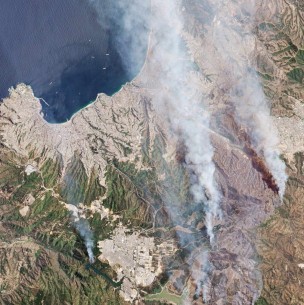
A fire that started on Friday 2nd and grew exponentially because of the wind and the dry, hot climate. More than 100 people are dead, with 70 unrecognized bodies and other 400 that have dissapeared. At least 30000 people that have lost everything to the fire.
There's massive evacuations from this and the neighboring city, Viña Del Mar.
This is said to be the second most deadly fire in the century, surpased by Australia in 2009.
45000+ hectares that include land and neighborhoods have been burnt down.
I could go on about this one, so more info here and here
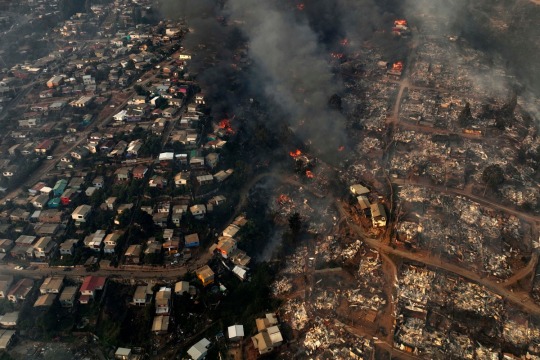
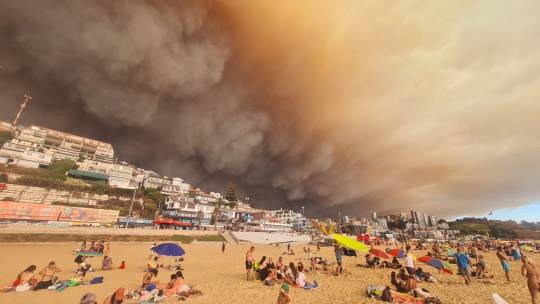
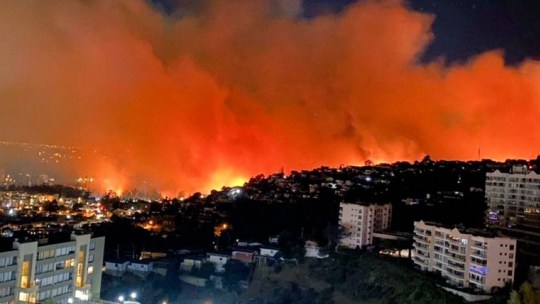
Argentina
Parque Los Alerces (Esquel), Chubut
The fire strarted on the 25th January, and the climate has made it hard to contain. 3000 hectares of native forest have been burnt to teh ground. It is now growing in the direction of the nearest city, Esquel. Theres been evacuations between yesterday and today (4 and 5th Febuary)
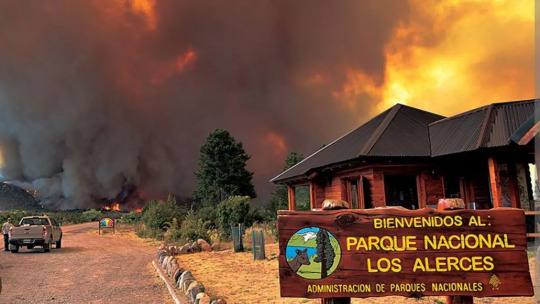
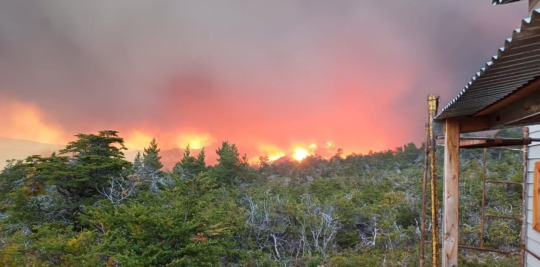

Parque Nahuel Huapi (Bariloche), Río Negro
The reason why im writing this. The city woke up today covered in smoke after a wildfire developed yesterday during the night. The reason? A fireplace that was not turned off in a place where people cannot disembark and can only be reached via boats.
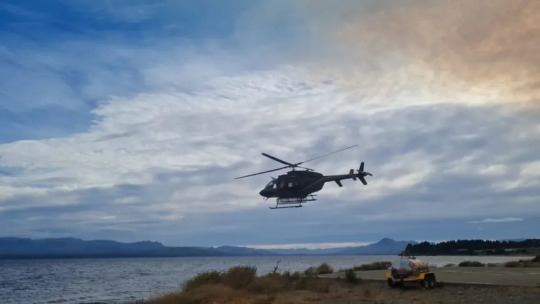

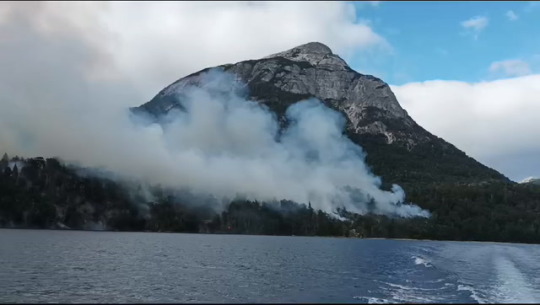
As of now, there's not much information about the fire but hopefully the firefighters will be able to contain it before it reaches Tronador Mountain, where an ancient glaciar is.
...which leads me to the other point i wanted to talk about.
Firefighters
They volunteer to do this job.
In Argentina and Chile, firefighting is not rewarded with a salary, and most of the times they dont even have full firehouses to stay in. These people are at their houses, ready to jump into action and run to the station the second the alarm goes off.
They are neighbors, people that risk their lives and run into danger willingly, just because they want to help the community.
I felt the need to give a shout-out to these people and say:
Don't be a fucking dick, don't start fires in the woods unless it's an approved place, and if you do, TURN IT OFF.
Pour abundant water on it, and do not stop when you don't see any more flames.
Keep pouring water until the ashes don't burn/feel like room temperature in your hand if you put it 10 cm away from it, and even then, pour some more just to be sure.
No heat and no smoke mean a safely extinguished fire.
Save lives and forests.
#dont even get me started on the denial of climate change from my president#didnt wanna get political here#argentina#chile#argieposting#argieblr#soff speaks#wildfires
6K notes
·
View notes
Text
Raging Wildfires in Chile - Please Reblog!
Over a hundred people found death and counting, as neighbors and volunteers gather to remove debris by their own means. This wildfire has spread along three different cities, urban and rural spaces included. Arson is claimed.
Many people and pets are still missing, their whole lives destroyed by these aggresive fires as they reached urban villages, thousands evacuated from their home. Please help us create some awareness with a little reblog and maybe some help, as firefighters and other official charities [TECHO chile, Desafío Levantemos Chile, Hogar de Cristo] are accepting donations.
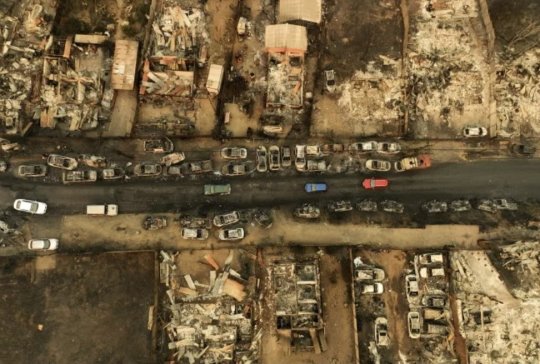
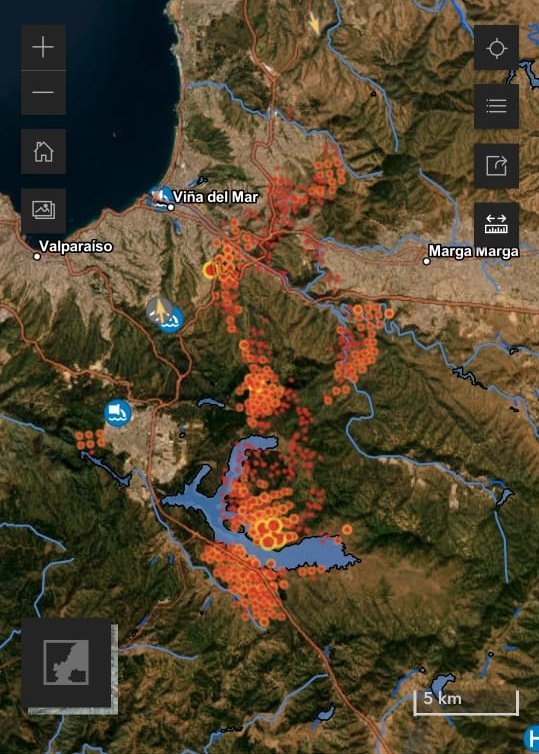
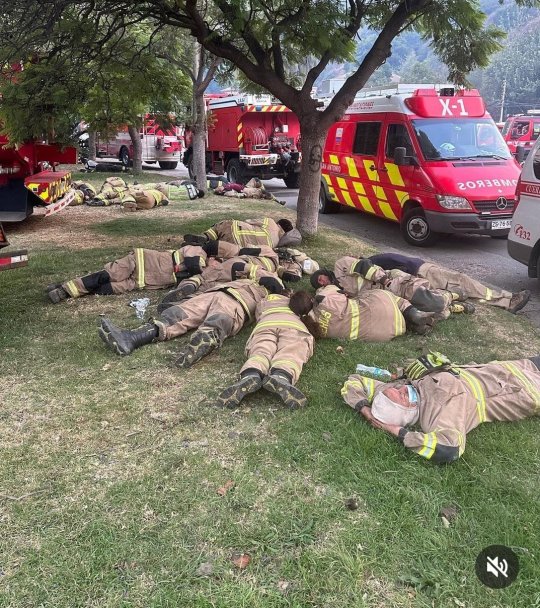
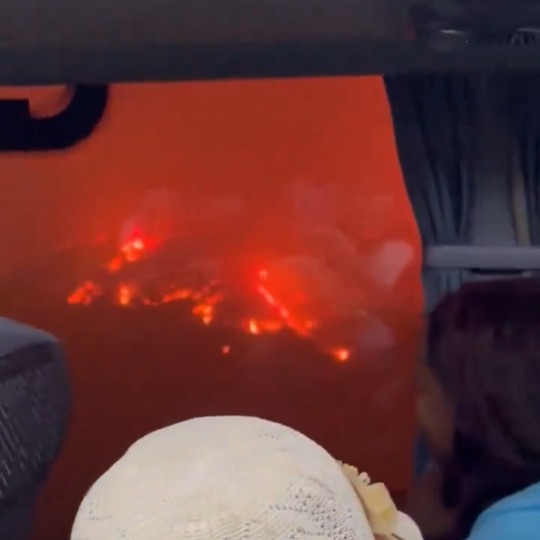

#wildfires#awareness#late capitalism#climate crisis#climate catastrophe#chile#Valparaíso#global news#i've been personally affected as well since my place is near to one of the wildfires...... so please help me by sharing :(
246 notes
·
View notes
Text










Currently in chile there are wildfires devastating the region of Valparaiso, so far at least a hundred people have died and hundred more have been displaced by the loss of their homes. So we are doing a raffle in exchange for donations. To participate and see the rest of the prizes CLICK HERE and follow the instructions
1 minimum donation of 3usd to Desafio levantemos chile = 1 raffle entry.
There will be multiple winners per item and per artist so good luck and let's hope this little help can bring relief to the families. If you can't donate please reshare this post.
Thank you again to everyone who helped me put this together in such a short notice. -------
Si eres de chile HAZ CLICK ACA para donar. Monto minimo de $1000CLP
2 notes
·
View notes
Text
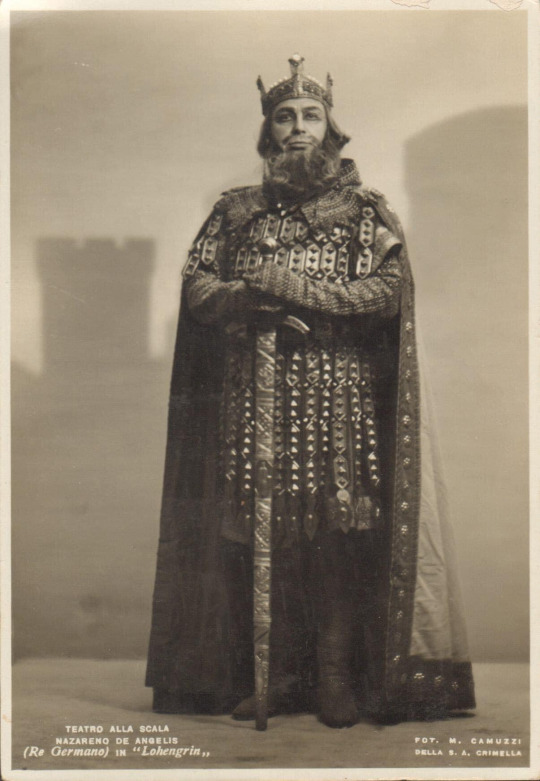
Here we see the Italian bass Nazzareno de Angelis (1881 – 1962) as King Henry from Lohengrin. I love the imposing costume and regal pose.
De Angelis was born at L’Aquila on 17 November, 1881 and began his musical life as a boy soprano, first with local choirs, then at the Capella Sistina in the Vatican. After his voice lowered, he studied with one Dr. Faberi at the Accademia di Santa Cecilia in Rome. For several years, he and his mentors wondered about his true vocal placement, and he studied both baritone and bass scores with equal intensity. The top of his voice was tremendous, but it became increasingly clear that it was centred where kings, prophets and devils live. His last two years at the Accademia were spent developing repertoire, and he gave several recitals there before making his opera début at the Comunale of L’Aquila in May of 1903 in Linda di Chamounix, followed by an opera called“L’Educate di Sorrento, by E. Usiglio, at the same theatre.
Hearing of his enormous success the management of Rome’s Teatro Quirino immediately engaged him, and, in early July, he débuted in Norma. He subsequently appeared at the Teatro Adriano as Il Spettro in Hamlet, to the Ofelia of Maria Barrientos and the Hamlet of Battistini, followed by Rigoletto and Tosi Orsini’s Yanthis. In 1904, after some twelve performances of La Gioconda at the Teatro Lirico of Milan, he appeared at Santa Maria Capua Vetere as Colline and at the Quirino in La Favorita, Il Barbiere di Siviglia (Basilio), Carmen (Zuniga), Ernani, Norma and Rigoletto. Carlo Galeffi was his Rigoletto in several performances. He toured the Netherlands from December of 1904 to May of 1905, singing such diverse roles as Dr. Grenvil in La Traviata, Zuniga in Carmen, Sparafucile in Rigoletto, Ferrando in Il Trovatore, Fouquier-Tinville in Andrea Chénier, Tom in Un Ballo in Maschera, Angelotti in Tosca, Basilio and Raimondo in Lucia di Lammermoor. The company gave performances in Amsterdam, Rotterdam and The Hague.
In the Autumn of 1905 he appeared at Mirandola in La Gioconda, at Parma’s Teatro Reinach in Rigoletto and Faust, and at Cagliari’s Teatro Regina Margherita as Alvise, along with those first historic performances of Mefistofele. Gaspare Nello Vetro’s Teatro Reinach says of his Faust Mefistofele: “The young Nazzareno De Angelis, now at the outset of his career, received the greatest applause and had to repeat ‘Dio dell’ Or’ at every performance.” At Cagliari, after his first performance of Boito’s Devil, the applause was interminable and it immediately led to a contract at Bari’s very important Teatro Petruzzelli, where he added Lohengrin and Iris to his roster of operas.
In the Spring of 1906 he left on his first South American tour, appearing at Santiago de Chile and Valparaiso from June to November. He sang nine roles to enormous success. On 16 August, the region was stunned by an earthquake so severe that performances had to be suspended until 1 September. The opera house at Valparaiso was almost completely destroyed, and it was there that the greatest damage occurred. Hundreds of people died, and the wounded numbered in the thousands. Despite recurring after-shocks, the season eventually returned to normal and, in addition to his scheduled performances, he participated in several hastily arranged benefits for earthquake victims. Among his new assignments were Ludovico to the commanding Otello of Antonio Paoli, and Marcel in Gli Ugonotti. His receptions were increasingly enthusiastic, and, before the season ended, he happily agreed to return. That agreement was honoured in both 1908 and 1909. El Mercurio said of him: “…. at the end of the Prologue to Mefistofele, De Angelis received a huge and most sincere ovation.” A later review stated that “he has reminded us again as Mefistofele how superb an artist he is, and in Germania has made us marvel at his versatility in this new role”.
The 1908 season saw him in eight operas including Gli Ugonotti with Hariclea Darclee, and in 1909, he sang nine roles including the creator part of Aquilante in Gloria After his appearances at Santiago, he is thought to have sung in Buenos Aires at the Teatro Coliseo, but no details have been unearthed about his roles during that engagement. He returned to the South American continent in 1910, 11, 12, 14, 19 and 1926, and he appeared in Buenos Aires, Rosario, Montevideo, Rio de Janeiro and São Paolo. He sang Mefistofele in every theatre at which he appeared, and in every season, except for 1914. The list of operas he performed in South America only is long: Tannhäuser, La Sonnambula, I Puritani, Gomes’s Il Guarany and Salvator Rosa, Galitsky in Prince Igor (his only Russian opera, though sung in Italian), Les Huguenots (also in Italian), de Campos’s Um Caso Singular, Verdi’s Otello and Franchetti’s Germania.
On 15 January, 1907 he débuted at La Scala as Alvise in La Gioconda and appeared for the first time in Tristan und Isolde, La Wally and as Aquilante de Bardi in the world premiere of Cilea’s Gloria. Despite recurring arguments with the theater’s management, including one four year hiatus, he would sing twenty four roles over twelve seasons. The year offered two other very important debuts, Alvise at the Teatro Verdi of Firenze with Eugenia Burzio, and King Marke at Bologna’s Teatro Comunale with Amelia Pinto, Giuseppe Borgatti and Giuseppe Pacini. Tristan und Isolde received fifteen performances and was followed by De Angelis’ only appearances in Tschaikovsky’s Iolanthe.
1908 brought with it the beginning of his Scala partnership with Ester Mazzoleni. They first appeared in Franchetti’s Cristoforo Colombo conducted by Toscanini in a run of 16 performances, followed by a revival of La Forza del Destino. Mazzoleni described the event:
You will not be able to imagine what happened on that opening night. Icilio Calleja started ‘O tu che in seno agli angeli’ both too soon and out of tune, at which point all hell broke loose in the house. The theatre took on the atmosphere of a bullring, and, as often happens when things are not going well, the audience vented its rage at everything in sight. Both Pasquale Amato and Luisa Garibaldi were booed and hissed without mercy. The only ones who escaped their fury were De Angelis and myself. At the end, after almost collapsing from nervous exhaustion, we received a standing ovation. Notwithstanding our personal success, Toscanini, eyes ablaze, cancelled the remaining performances.
On 19 December, 1908 De Angelis and Mazzoleni appeared in the historic production of Spontini’s La Vestale, a revival that was repeated 16 times, and then travelled to Paris. Verdi’s I Vespri Siciliani was next in the list of successes, and, on 30 December, 1909, they caused a sensation in Cherubini’s Medea. In March 1910, they appeared in what was to be their last opera together, Meyerbeer’s L’Africaine. This unbroken string of personal triumphs is one of the most legendary of all stories associated with the Milan theatre. Among other memorable evenings at La Scala was the world première of Montemezzi’s L’Amore dei Tre Re on 10 April, 1913 in the role of Archibaldo, which he later premièred at the Colón of Buenos Aires, the Costanzi of Rome, Rio de Janeiro, São Paolo and Trieste’s Teatro Verdi.
Of his Archibaldo in the Rome première of L’Amore dei Tre Re, Il Tempo, on 15 March, 1919, said: “De Angelis, the old lion, he of the pungent, powerful voice, sang the ideal performance of Montemezzi’s king.”
Most of 1910 was spent in the Western Hemisphere. On 31 May De Angelis debuted at Buenos Aires’ Teatro del Opera in Lohengrin with Salomea Krusceniski, Luisa Garibaldi, Dygas and Riccardo Stracciari ,and he completed his season in Aida with Giannina Russ, Garibaldi, and Giovanni Zenatello, Norma with Russ, Garibaldi and Dygas, Mefistofele with Krusceniski and Dmitri Smirnov and Gotterdammerung with Krusceniski and Dygas. In August, the company visited Montevideo for a three week season. after which De Angelis traveled to Chicago for his only performances in the United States.
On 3 November, 1910 he sang in the inaugural performance of the Chicago Civic Opera Company as Ramfis. The cast included Karolewicz, de Cisneros, Bassi, Sammarco and Dufranne. He subsequently sang Colline in La Boheme with John McCormack, Raimondo in Lucia di Lammermoor and Ashby in La Fanciulla del West. On 18 January 1911, in a closing night gala, he appeared as Ashby with Carolina White, Caruso and Sammarco. It is curious that De Angelis accepted a contract with Chicago for roles so small when he had already become the most important bass at La Scala and in many of South America’s theatres. Perhaps the heady company that he would be keeping attracted him; that, with the hope that other more important roles would come his way. He visited several other cities, but, outside of a single appearance in Fanciulla del West at Milwaukee in November.
Upon his return to Italy, De Angelis prepared for the most important début of his career: the Costanzi of Rome. The theatre was to present a gala ‘Musical Exposition’ of opera and ballet in celebration of the fiftieth anniversary of the declaration of the Kingdom of Italy. Among the notable events were the company premières of Verdi’s Macbeth and Donizetti’s Don Sebastiano and the Italian première of La Fanciulla del West, with Eugenia Burzio and Giovanni Martinelli. Serge Diaghilev’s Ballet Russe presented local premières of Les Sylphides and Giselle with Nijinsky, and Toscanini conducted several of the operas. In the midst of this carnival of riches, on 16 April, 1911, De Angelis débuted as Don Basilio with the stellar cast of Graziella Pareto, Umberto Macnez, Titta Ruffo and Giuseppe Kaschmann. The theatre was packed with family, friends, colleagues from his days at the Vatican and the Conservatorio, and former teachers. Dal Costanzi all’Opera states that “it was an evening of surpassing grandeur, refinement and polish, a performance beyond any criticism”. Il Giornale d’Italia reported that “De Angelis convinced a highly expectant audience that he is truly an artist of the first rank….The tumultuous applause that greeted the singers became a roar each time that he appeared before the great curtain”. He was to tell Paolo Silveri many years later that it was the most emotionally satisfying evening of his career. The bond between singer and city had been permanently cemented and he would return in thirteen additional seasons in seventeen roles.
On 23 May, De Angelis debuted at the Teatro Colon in Buenos Aires as the Landgrave in Tannhauser with Pasini-Vitale, Ferrari-Fontana and De Luca. He sang in ten operas, including his first performances in Don Carlo with Agostinelli, Garibaldi, Constantino and Ruffo, La Sonnambula with Barrientos and Bonci and I Puritani with Barrientos, Bonci and De Luca. The Colon hosted him the following year in seven operas, including his only performances as Friar Lawrence in Gounod’s Romeo et Juliette with Lucrezia Bori and Giuseppi Anselmi. De Angelis sang at the Colon for the last time in 1914, but he returned to Buenos Aires in 1919 as Basilio, Mefistofele, Galitzky, Mose and Archibaldo at the Teatro Coliseo.
On 10 October, De Angelis sang Mefistofele at the Costanzi for the first time, and it would be the defining event of his career. The first night audience cheered for nearly an hour and the next day’s reviews were among the most laudatory ever seen:
Mefistofele at Rome - Il Corriere d’Italia - 11 October, 1911. “This singer and magnificent actor can truly claim to be the greatest basso currently on the lyric stage. Extraordinary power, an excellent voice, clear and perfect diction and impeccable technique were all completely confirmed last night. His success was enormous.”
His triumph was reported on the front page of newspapers throughout Italy and he was immediately asked to sing the role in virtually every Italian theatre. Within four months he had débuted at Turin’s Regio, Trieste’s Verdi and the San Carlo of Naples, where he sang fourteen performances of the opera. Barcelona’s Liceo received him with enormous acclaim in April of 1913 and Mefistofele was to serve as his debut role at Venice’s Fenice, Genoa’s Carlo Felice and Politeama, Brescia’s Grande, Padua’s Verdi, Palermo’s Massimo and the Verona Arena. In 1918, De Angeles sang the role for the first time at La Scala with Linda Cannetti, Elena Rakowska and Gigli, and, in 1920, at Milan’s Dal Verme, he appeared in some fifteen performances of the opera with Hina Spani as Margherita. It was so overwhelming a part of his career, that in 1923, it was the only role he sang.
On 4 April, 1915, he sang Mosè for the first time, appearing at Rome’s Teatro Quirino and took the role to Firenze, Livorno’s Teatro Goldoni, the Comunale of Bologna and Milan’s Dal Verme. The cast included Giannina Russ, Adele Ponzano, Luigi Pieroni and Alessandro Dolci, and was conducted by Mascagni. The tour was among the very few performances he gave between the Spring of 1915 and the Winter of 1918. A 1916 press release from the Teatro Municipal of Santiago, Chile notes that, because he was serving in the Italian armed forces, he would not be able to appear. He returned to the stage at Rome’s Costanzi in February, 1918, and sang Mosè there on 23 April.
Mosè - 2 June, 1918 - Rome Dal Costanzi all’Opera. “On the closing night, which presented the tenth performance of Mosè, De Angelis achieved one of the greatest successes of his career.”
La Tribuna said: “The great bass received an ovation perhaps without parallel in memory. His performance was of monumental proportions, and the audience responded in kind.”
Over the next several years, De Angelis sang Mose at La Scala, Buenos Aires, Rosario, Montevideo, Rio de Janeiro, Sao Paolo, Bergamo, Genoa, Ferrara, Trieste, Turin, Ancona, and, for the last time in 1925 at the Verona Arena.
Although De Angelis’ stage debut was in Linda di Chamounix, Donizetti and Bellini seem not to have been composers for whom he felt much affinity. In 1911, he sang in La Sonnambula and I Puritani at the Colón of Buenos Aires and, on the closing night of the 1926 season at Rio de Janeiro, he sang one additional lonely performance of I Puritani. By 1912, he had stopped singing in La Favorita and Lucia di Lammermoor and seems never to have appeared in a Donizetti opera again. He sang important revivals of Norma with Giannina Russ, Claudia Muzio, Vera Amerighi-Rutili, Bianca Scacciati and Iva Pacetti, but they were few in number and widely separated in time.
Lucia di Lammermoor at Buenos Aires - La Prensa - 27 May, 1911 Though the soprano role is the centrepiece of this opera, Barrientos’s grand companions, Constantino, Ruffo and De Angelis were all triumphant.
Norma at Rome - Il Tevere - 28 December, 1928 The evening confirmed the triumph of Norma, and of Muzio, Luisa Bertana, the tenor Mirassou and Nazzareno De Angelis, who conferred, with beauty of voice and physical presence, the ultimate realization of Oroveso.
Don Basilio in Il Barbiere di Siviglia was a very important role in De Angelis’s career, and he sang it in both the largest and smallest theatres. In the Spring of 1916 he toured among Parma’s Regio, Naples’ San Carlo, Pisa’s Verdi, Pesaro’s Salon Pedrotti and Rome’s Quirino in commemoration of the 100th anniversary of the opera’s premiere. The cast for the performances was Fanny Anitua as Rosina; Carpi and Macnez sang Almaviva; Galeffi portrayed Figaro and Kaschmann, Bartolo. At Rome, the cast included de Hidalgo, Salvati and De Luca. He sang it at the Costanzi in 1919 and garnered his usual superlatives.
Il Barbiere di Siviglia at Rome - Il Messagero - 16 February, 1919 “This old opera rarely has one divo, fewer times two, but tonight there were four, de Hidalgo, Schipa, Galeffi and De Angelis, truly an Olympus of singers. It was a marvellous evening, one which made us almost believe that we were seeing the opera for the first time. The soloists sang as though inspired by some magic spirit.”
In 1919, De Angelis toured to Buenos Aires, Montevideo, Rio de Janeiro and Sao Paolo as Basilio with Angeles Ottein, Tito Schipa and Armand Crabbe. It was on this tour that he appeared in Prince Igor, Il Guarany and Salvator Rosa for the only times in his career. In 1921 he appeared as Basilio at Spoleto with the inimitable Conchita Supervia and in 1922 he appeared in a lavish production at La Scala with de Hidalgo, Hackett and Galeffi. In 1925 he made both his Swiss debut and farewell as Basilio at Lugano.
His Wagner roles were seven: King Marke in Tristan und Isolde, Wotan in both Das Rheingold and Die Walküre, King Henry in Lohengrin, Hagen in Götterdämmerung, the Landgrave in Tannhäuser and Gurnemanz in Parsifal. In 1914, he sang Gurnemanz an amazing twenty seven times during La Scala’s first season of Parsifal and premièred the opera at Buenos Aires’s Teatro Colón the following May. In January 1922, he returned to La Scala for eleven performances in a cast that included Helene Wildbrunn, Amadeo Bassi, and on the fourth night, the debut at that theater of Apollo Granforte. He appeared at Paris as Gurnemanz in May of the same year. De Angelis appeared in Die Walkuere at Rome, La Scala, Naples, Rio de Janeiro and Sao Paolo and in Das Rheingold at Bologna, Rome and La Scala. In the winter of 1938 at Rome, he sang Wotan in Das Rheingold and Die Walküre, as well as Hagen, in the first ‘Ring’ ever performed completely in Italian. The undertaking was supervised by Tullio Serafin and the four operas were broadcast throughout Italy. De Angelis’ last Wagner performances were as Gurnemanz at the San Carlo of Naples in April, 1938.
Of his performances in the 1938 ‘Ring’at Rome, the following reviews are quoted.
Il Messagero, 25 January - Das Rheingold De Angelis sang with enormous resonance. His achievement was hard to imagine, sung with the greatest of expression, vigour and vibrancy.
Il Piccolo, 27 January - Die Walkuere He maintained a level of excellence throughout this very long and difficult role that was exceptional.
Among Verdi’s operas, he sang Zaccaria in Nabucco, Silva in Ernani. Ferrando in Il Trovatore, Grenvil in La Traviata, Sparafucile in Rigoletto, Tom in Un Ballo in Maschera, Padre Guardiano in La Forza del Destino, Procida in I Vespri Siciliani, Fiesco in Simon Boccanegra, King Philip in Don Carlo, Ramfis in Aida and Lodovico in Otello. Interestingly, he sang far fewer performances of Verdi than he did of Wagner. In fact, in no Verdi opera, outside of Aida, did he sing more than twenty five performances, and Simon Boccanegra, had only one revival, at La Scala in 1933. It was his last new role.
Aida - Rome - La Tribuna - 6 October, 1911 The Ramfis of Nazzareno De Angelis showed an extraordinarily robust, mellow and vibrant voice.
Nabucco - Rome - La Tribuna - 2 June, 1916 A memorable evening of art, of patriotic love.... in which all the artists offered a spectacle of singular interest. The interpreters, Nazzareno De Angelis in the white robes of the high priest, Zaccaria, Carlo Galeffi, Cecilia Gagliardi and Fanny Anitua gave superb examples of their great art.
Non-operatic appearances were fairly infrequent. He sang in Verdi’s Manzoni Requiem several times, most importantly at La Scala in 1913 under Toscanini’s direction, at Rome’s Teatro Augusteo in both 1913 and 1922, and in 1924 at Vicenza and the Verona Arena. The Verona engagement with Rinolfi, Minghini Cattaneo and Taccani, was so successful that after two performances in the outdoor stadium, an additional two were given at the Teatro Filarmonico with Lucia Crestani singing the soprano music. In May 1938 he returned to the work for the last time when he sang it at Rome’s Teatro Adriano with Caniglia, Stignani and Alessandro Granda. On 4 December 1924, under Toscanini’s direction, he and Hina Spani sang at Giacomo Puccini’s Funeral in the Duomo of Milan, and on the 29th , the program was repeated at La Scala. Among De Angelis’ more interesting concerts were three at Rome’s Teatro Quirino. On 4 April 1915 he appeared with Russ and Battistini in an all Mascagni programme honouring the composer. In September, 1915 he appeared in a composition called Inno alla Patria by Zandonai accompanied by Gabriella Besanzoni, and in June 1916, he sang in Canto di Guerra, written by the great bass-baritone Giuseppe Kaschmann.
De Angelis’ career in Iberia was not impressive. He sang Mefistofele at La Coruña, Spain in 1908 and appeared at Barcelona’s Liceo in the Spring of 1913 as Boito’s Devil. The La Coruña engagement includes a reference to Gounod’s Faust, which, if it were to have happened, would have been an extremely interesting juxtaposition of roles. Perhaps it did. There are announcements of a second engagement at La Coruña in 1912, but I have found no details. It would seem, from the evidence, that he never appeared in Portugal.
By 1927, De Angelis was averaging no more than 20 performances a year, though he continued to make recordings at a prodigious rate. In 1934, his only appearances were as Mefistofele at Piacenza and, about a year later, he sang Oroveso, Gurnemanz and Padre Guardiano at Genoa’s Carlo Felice. After a three-year absence, he returned to Rome’s Teatro Reale in January of 1938 for Mefistofele and the celebrated ‘Ring Cycle’. In August, after a debut at Rome’s Caracalla as Mefistofele, he sang his valediction at Naples’ Arena Flegrea as Boito’s Beelzebub, with Delia Sanzio, Margherita Grandi and Granda. De Angelis had appeared in fifty seven operas and had sung well over fifteen hundred performances.
It has been reported that he gave occasional recitals until about 1942. Upon his eventual retirement, he taught in Milan and, later, at his favorite city, Rome. He died on 14 December, 1962, in Rome, at the age of 81.
#classical music#opera#music history#bel canto#composer#classical composer#aria#classical studies#maestro#chest voice#Nazzareno de Angelis#bass#Lohengrin#Richard Wagner#Wagner#Paris Opéra#La Scala#classical musician#classical musicians#classical voice#classical history#classical art#musician#musicians#music education#music theory#history of music#historian of music#diva#prima donna
5 notes
·
View notes
Text
Brazilian Ascendancy
King John VI of Portugal has announced the abolition of Portugal, crowning himself the Emperor of Brazil.
He immediately marches on Uruguay, but finds no army to oppose him, as the Uruguayans have launched an invasion of Paraguay. Pursuing them there, he annihilates them at the Battle of Cerro Cora, where Artigas is killed by a Brazilian lancer. Uruguay is annexed by Brazil.
The Republic of Nariñia
Upper Peru, now renamed to Nariñia, successfully fends off two simultaneous Spanish and Brazilian invasions, leading to de Sucre being proclaimed "the most popular man in the Americas."
Chile and the Rio de la Plata
A diplomatic ship sails out of Valparaiso harbor, destination unknown.
In the Rio de la Plata, de Liniers and San Martin have their final showdown. After a protracted siege of Buenos Aires, in which thousands of men, women, and children take part in the defense, de Liniers takes the city after French blockade runners deliver heavy artillery guns to the royalist army. After marching triumphantly into Buenos Aires, de Liniers proclaims the independence of the Rio de la Plata, and formally enters into an alliance with Napoleonic France.
The Conquest of America
After rapidly attacking and annexing Panama, Iturbide begins the construction of the Panama Canal. Next, Iturbide occupies the British Pacific Northwest, before moving against Burr's flailing army. Destroying Burr's command to a man, the People's Liberation Army crosses the border in force to invade the United States of America.
As the British burn Washington, Iturbide waters his horse in Saint Louis, Missouri. Then, in a march across the Deep South, PLA general Guillermo Moctezuma Sherman frees millions of slaves, burns every city in his path, and reclaims Florida for the PRA.
Iturbide, after signing a treaty with Britain to divide the conquered United States along the Mississippi River, marries his beloved secretary Telepe in the smoldering ruins of New Orleans.
The Most Hated Man in the Americas
Following the series of harrowing engagements with the Spanish, Narino retreats to the Andes mountains, joining with many other important revolutionary leaders. Santander, Moreno, Rondon, and Cordoba all join Narino in this last stand. To the surprise of many, the Spanish do not attack the rebels, instead consolidating their position on the coast. After that, Ferdinand focuses solely on the defense, and lets Narino consolidate. Ambitious and petty, Bolivar crosses from Venezuela, believing Narino to be on their last ropes, and hoping to score a quick victory against both sides. This does not go as planned, however. Narino's spies warn him ahead of time, and the defense pivots. All the while, Bolivar is plagued with desertions. When the final battle comes, Narino destroys Bolivar, and sweeps through New Granada and pushes into Venezuela, conquering the whole region. Bolivar flees to Madrid, as effigies of him are burned throughout the Americas. From Chile With Love
The diplomatic ship from Valparaiso arrives in Lima, Spain. As Ferdinand returns from the battlefield, content that the past years of hell are finally over, a Chilean lights a fuse on the ship and jumps overboard.
A minute later, the vessel explodes, flattening Lima, and leaving no trace of the Spanish royal family.
0 notes
Text
Allanamiento simultáneo nacional se realizó en cárceles de Quillota y Valparaíso.
Nueva publicación en https://www.laopiniononline.cl/allanamiento-simultaneo-nacional-se-realizo-en-carceles-de-quillota-y-valparaiso/
Allanamiento simultáneo nacional se realizó en cárceles de Quillota y Valparaíso.
Los 33 operativos, ejecutados hasta la fecha, suman un una incautación de 23.200 armas blancas, 10.752 teléfonos celulares, 6.394 litros de licor artesanal y casi 48 kilos de droga.
Las unidades penales de Valparaíso y Quillota formaron parte del último procedimiento de registro y allanamiento masivo. Ambos procedimientos se desarrollaron durante la tarde de este lunes y permitieron incautar una serie de elementos prohibidos que pueden poner en riesgo la vida de los funcionarios y/o población penal.
El primer operativo comenzó a las 16:40 horas en el Centro de Detención Preventiva de Quillota. Personal uniformado del recinto, junto a efectivos de la Unidad de Servicios Especiales Penitenciarios (USEP) de Quillota ingresó al pabellón 5, habitado por privados de libertad condenados. Una hora más tarde fue el turno de los funcionarios del Complejo Penitenciario de Valparaíso, el que ingresó al módulo 103 para desalojar a los internos y proceder a revisar cada una de las celdas y lugares comunes.
El director regional de Gendarmería, coronel José Luis Meza Guajardo, afirmó que “el procedimiento fue impecable, con mucho profesionalismo por parte de nuestro personal, tanto de los grupos especializados como del personal de trato directo, que efectuaron los registros y allanamientos. Se decomisó droga, elementos cortopunzantes hechizos y también teléfonos celulares”.
Tal como sostuvo el coronel Meza, se logró incautar 17 teléfonos celulares, 57 armas blancas de fabricación artesanal, tres cargadores y tres envoltorios con cannabis sativa.
“Estos procedimientos se hacen de forma preventiva, de forma planificada, para encontrar todos estos elementos prohibidos, que ponen en riesgo la seguridad del régimen interno de los recintos penitenciarios. Es fundamental poder mantener estos registros, tanto corporales de la población penal, como también de las dependencias que ellos utilizan habitualmente”, agregó el director regional.
Allanamiento Quillota
PAÍS
En el Cuartel de Entrenamiento de Grupos Especiales de Gendarmería, ubicado en la comuna de Santiago, el Ministro de Justicia y Derechos Humanos (s), Jaime Gajardo Falcón y el Director Nacional de Gendarmería, Sebastián Urra Palma, entregaron un balance de lo incautado en las últimas horas, en allanamientos simultáneos, efectuados en 31 unidades penales del país.
El trabajo del personal de los grupos especiales de Gendarmería permitió la incautación de 806 armas blancas; 376 teléfonos celulares; 121 litros de licor artesanal; y un kilo 792 gramos de sustancias ilícitas. El procedimiento abarcó una población penal de 7.844 personas, en 16 regiones del país. Para ello, el Departamento de Seguridad Penitenciaria de Gendarmería, desplegó una fuerza operativa de 1.766 funcionarios y funcionarias.
Respecto a los teléfonos celulares, cabe precisar que se identificó a 13 internos que portaban un aparato móvil, quienes fueron denunciados por Gendarmería al Ministerio Público. Esta acción, se enmarca en la Ley que tipifica como delito la tenencia de celulares en recintos penitenciarios, aprobada por el Congreso en agosto pasado.
El Ministro de Justicia y Derechos Humanos (s) Jaime Gajardo Falcón, explicó que “estos procedimientos son parte de la Política Penitenciaria, que hemos elaborado desde el Gobierno, junto con Gendarmería, para mantener establecimientos penitenciarios seguros, donde el control del Estado sea total. Hemos tenido un operativo exitoso, liderado por los grupos especializados de Gendarmería, incautando gran cantidad de elementos prohibidos que ponen en riesgo la seguridad penitenciaria y la integridad física del personal. El trabajo de la seguridad, al interior de recintos penales, es una labor constante y permanente”.
El Director Nacional de Gendarmería, Sebastián Urra Palma, agregó que el operativo se llevó a cabo de manera exitosa, recalcando que “se suma a los registros que se hacen de manera cotidiana en los diferentes establecimientos penitenciarios del país. Estos allanamientos son efectivos, y se realizan resguardando la seguridad de nuestros funcionarios y funcionarias, de los equipos que ejecutan el procedimiento, y de las personas privadas de libertad. Con este tipo de operativos, aseguramos el control total de los establecimientos penitenciarios y entregamos seguridad a la ciudadanía”.
Los 33 operativos, ejecutados hasta la fecha, suman un total de 1008 unidades penales intervenidas; 62.757 funcionarios de fuerza operativa, abarcando a 211.838 personas privadas de libertad; con una incautación de 23.200 armas blancas, 10.752 teléfonos celulares, 6.394 litros de licor artesanal y casi 48 kilos de droga.
Los operativos de registro y allanamiento simultáneos, realizados a nivel a nivel nacional, son parte del Plan de Seguridad Penitenciaria Contra el Crimen Organizado, impulsado por el Ministerio de Justicia y Derechos Humanos desde junio del 2022, a través de Gendarmería de Chile.
0 notes
Text
INTERNACIONALES - CHILE
🚨EN LAS ULTIMAS HORAS SE REGISTRARON INCENDIOS FORESTALES EN CHILE QUE DEJARON AL MENOS 19 MUERTOS.
🚒EN ESE CONTEXTO, EL ESTADO CHILENO DECLARO ESTADO DE EXCEPCION POR CATASTROFE. LAS AUTORIDADES ASEGURARON NUNCA HABER VISTO ALGO ASI.
"ESTAMOS FRENTE A UNA CATASTROFE SIN PRESEDENTES (...)", ADVIRTIO LA ALCALDESA DE VIÑA DEL MAR, MACARENA
ACTUALMENTE, LOS SERVICIOS DE EMERGENCIA Y BOMBEROS LUCHAN CONTRA 10 FOCOS ACTIVOS QUE AFECTAN VALPARAISO Y LAS REGIONES DE O'HIGGINS, MAULE, BIOBIO, LA ARAUCANIA Y LOS LAGOS.
🚒LA CORPORACIÓN NACIONAL FORESTAL (CONAF) INFORMO QUE EL INCENDIO FORESTAL DE MAYOR MAGNITUD ES EN LA RESERVA LAGO PEÑUELAS, CON MAS DE 7000 HECTAREAS AFECTADAS.
0 notes
Text
Oh, I do like to be beside the seaside!
Saturday 25th November - Valparaiso
We caught the Turbus from Almeda bus terminal in Santiago (Universidad de Santiago stop on the Metro) to Valparaiso yesterday morning. The route took us through the famous Maipo Valley wine region which was interesting, maybe we should have stopped there and tasted a few wines.
Valparaiso is billed as "a pretty seaside town with brightly coloured houses on the hillside rising up from the beach". This must have been written by an estate agent who describes a shed as "a bijou, character property with potential to extend"!
For "seaside" read port, for "brightly coloured houses" read covered in graffiti!
Valparaiso was clearly an important and elegant town at some point. There are some lovely period buildings with obvious French architectural influence in the centre. However, many if these are decaying and most are surrounded by scruffy, ugly 1950/60's style boxes. It was known as the most important port in South America in the mid 1800's when it was the closest port to the Magellan Straights, linking the Atlantic to the Pacific ocean. The opening of the Panama Canal in 1914 put paid to the prosperity of the city when the need to pass through the Magellan straights disappeared.
Once we arrived at our hotel overlooking the main square we dropped our bags in our room. Our plan was to go out into the town to explore but suddenly all hell let loose. There were sirens and horns blaring with numerous fire engines, ambulances and police cars speeding down the main roads towards our hotel. There were also 2 big wagons with "Bomba Espana" written on the front standing just opposite our window. "Here we go" I thought, "MM's done it again, she's stashed some dynamite from that bloody silver mine and now she's on Interpols most wanted list". The sirens etc continued for about 30 minutes but no one broke down the door or came for us. MM insisted that she was "clean", but there was a little glint in her eye that made me wonder. The same glint that she had in Melbourne when she managed to sneak 40 fags past the customs officers after they'd done her for smuggling another 200 - "ha, they didn't find these" was her triumphant refrain!
Anyway, disaster avoided (or postponed, time will tell), we set off to explore the old town, climbing the hill and roaming round the old, narrow cobbled streets. There are plenty of restaurants, gift and art shops and some pleasant views of the port and city but I think a day trip from Santiago would suffice, or, even better, visit the vine yards!
Not our favourite place to date, but unless you visit you never know.
0 notes
Text
Valparaíso
City in Chile

Panorámica de Valparaíso
Valparaíso is a port city on Chile’s coast. It's known for its steep funiculars and colorful, clifftop homes. La Sebastiana, the quirky former residence of Chilean poet Pablo Neruda, is now a museum with far-reaching Pacific views. During the 19th century, an influx of European immigrants left their mark on the city’s architecture and cultural institutions, many of which congregate around downtown’s Plaza Sotomayor.
Area code: (country) 56 + (city) 32
Capital: Valparaíso
Climate: Csb
Demonym(s): Porteño (m), P

Ascensor Artillería- Artillery Elevator

Edificio Armada de Chile - Chilean Navy Building

Cerro Bellavista- Valparaiso, Chile

Cerro Concepción-Historic Quarter of the Seaport City of Valparaíso

La Sebastiana

Monumento a los Héroes de Iquique-Monument to the Heroes of Iquique, Valparaiso, Valparaiso Region, Chile

Reloj Turri-Turri Clock, Valparaiso, Valparaiso Region, Chile
Valparaíso is a commune and capital city of the province and region of Valparaíso. It is located in the central area of Chile and is the historical, institutional and university center of Greater Valparaíso, which forms together with the municipalities of Viña del Mar, Quilpué, Villa Alemana and Concón. As the capital of the region, it is home to the Presidential Delegation and the Regional Government of Valparaíso, as well as being the seat of the National Congress, an important port terminal and one of the three most populous Chilean cities.
Valparaiso - Wikipedia, the free encyclopedia
Valparaíso — Wikipédia (wikipedia.org)

Paisaje urbano, Valparaíso, 2022.
96 notes
·
View notes
Text

7 notes
·
View notes
Text

Valparaíso, Chile
Cityscape♡
#region de valparaiso#valparaiso chile#valparaíso#original photography on tumblr#fotografia original#my photo#my photography
30 notes
·
View notes
Photo




Paseo por el Humedal Rio Aconcagua, de playa La Boca al cerro Mauco....
1 note
·
View note
Text
En un grupo de WhatsApp
O'higgins: oigan quien me puede mandar alguna foto de metropolitana?
O'higgins: necesito hacer un meme urgente
Biobio: yo te mando una pero me lo tienes que mandar después
Magallanes: mándalo por acá si po
O'higgins: dale
Biobio:

O'higgins: ME SIRVE PERFECTO
Valparaiso: AOFJAKFJAJFJAJFJSJDJS
Metropolitana: Que son maricones...
#chile#aph#hetachile#chiletalia#oc's#latin hetalia? tal vez#aph chile#region metropolitana#region del biobio#region general del libertador bernado O'higgins#region de valparaiso#valparaiso#O'higgins#biobio#metropolitana#lh chile#lh
13 notes
·
View notes
Photo

Algo por lo que vale la pena hacer lo correcto.
1 note
·
View note
Photo

Playa Ancha | Valparaíso Instagram: @chamorojas
#volkswagen#facade#Fachada#Valparaíso Chile#valparaiso#Region de Valparaíso#Chile#Valpo#Street Photography#urban photography#Photoblog
8 notes
·
View notes
Text
Cine, Música y Feria de Productos Locales este fin de semana en Estación Ocoa
Cine, Música y Feria de Productos Locales este fin de semana en Estación Ocoa


La proyección de la pelìcula chilena “Rara” (2016) más un conversatorio con su directora Pepa San Martín, el concierto de Pascuala Ilabaca y Fauna más músicos locales, además de la presentación de teatro de animación Lambe Lambe, un conversatorio sobre flora endógena y una feria de productos locales son las actividades que el Centro Cultural Itinerante Trenzando realizará entre el viernes 31 de…
View On WordPress
0 notes